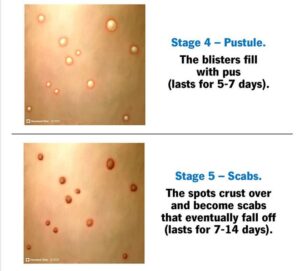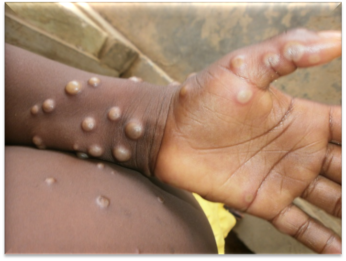Mpox, formerly known as monkeypox, may feel like a new health scare, but its history goes back several decades. The virus was first discovered in 1958 in Denmark when researchers noticed outbreaks among monkeys kept for scientific studies. However, the first human case was reported in 1970 in the Democratic Republic of Congo, a nine-month-old boy. Since then, the virus has been detected in several African countries, especially in Central and West Africa, where it became endemic.
For years, mpox was mostly seen in rural African regions with limited international spread. That changed in 2003, when the United States reported its first outbreak. At the time, 47 people across six states were infected, not through human-to-human transmission but from contact with pet prairie dogs that had been exposed to imported rodents.
The real global alarm came in 2022, when mpox cases began spreading across Europe, the Americas, Asia, and beyond. Within months, it turned into an outbreak affecting more than 120 countries. Unlike earlier reports, this outbreak was largely driven by close human-to-human contact, sparking urgent research into how the virus spreads.
What Is Mpox?

Mpox is an infectious disease caused by the monkeypox virus (MPXV), which belongs to the Orthopoxvirus genus, the same family as smallpox. While similar to smallpox, mpox is generally milder, though it can still cause severe illness in vulnerable groups.
The illness usually begins with flu-like symptoms such as fever, chills, muscle aches, and swollen lymph nodes. Within a few days, a distinctive rash appears, often starting as flat red spots, which then evolve into raised bumps, pus-filled blisters, and eventually scabs.
The rash can last between two to four weeks, and recovery typically occurs without treatment.
Although most people survive, complications such as pneumonia, sepsis, eye damage, and even death can occur. In fact, clade I (found mainly in Central Africa) has been associated with higher fatality rates compared to clade II, which is linked to the global outbreak.
Global Outbreaks: Why the Concern Has Grown
In the past, mpox outbreaks were small and relatively contained. But since 2022, the virus has shown a new face wider spread across continents. According to global health data, more than 100,000 confirmed cases have been reported worldwide since the start of the 2022 outbreak.
In the United States alone, there were about 1,700 cases in 2023, mostly linked to close and intimate contact. Meanwhile, the Democratic Republic of Congo continues to see thousands of infections every year, with children under 15 representing more than half of the cases in certain regions.
This unexpected global surge has left many wondering: How does mpox actually spread, and is it as contagious as airborne viruses like COVID-19?
Before we go further, let’s take a closer look at the signs and symptoms of Mpox.
Signs and Symptoms of Mpox
Understanding the symptoms of mpox is essential for early detection and treatment. Symptoms usually begin within 7 days of exposure, but in some cases, they may appear as late as 21 days.
Common symptoms include:
- Rash (often spreading across the face, hands, feet, or genitals)Fever and chills
- Swollen lymph nodes
- Fatigue and muscle aches
- Headache and sore throat
Not every patient develops all the symptoms. Some experience only a rash, while others may first have flu-like signs before the rash appears. In rare cases, individuals may not develop a rash at all, making diagnosis tricky.
Doctors often compare mpox with chickenpox or smallpox because of the skin blisters. However, swollen lymph nodes are a key feature that sets mpox apart.
How Is Mpox Transmitted?
The big question on everyone’s mind is: How is mpox transmitted? Unlike viruses that spread mainly through the air, mpox is not considered highly airborne. While it can spread through respiratory droplets when people are in very close face-to-face contact, the primary mode of transmission is through direct skin-to-skin contact.
This means contact with rashes, blisters, or body fluids of someone infected is the most common way to catch the virus. According to experts, specific situations that increase the risk include:
- Close, intimate interactions such as kissing, cuddling, or sexual contact.
- Sharing personal items like bedding, towels, or clothing.
- Contact with contaminated objects or surfaces.
- Transmission from pregnant women to their babies during pregnancy or birth.
- Animal-to-human spread from bites, scratches, or eating infected meat.
Therefore, while asking “is mpox airborne?” the answer is not in the same way as flu or COVID-19, but precautions are still needed during close contact.
Is Mpox Deadly?
Most mpox cases are mild, but the severity depends on the virus strain (clade) and the health of the infected person.
- Clade I, mostly found in Central Africa, has historically had a fatality rate of around 10%.
- Clade II, linked to the global outbreak since 2022, is much less deadly, with a fatality rate below 3.3%.
For healthy adults, the chance of survival is high. However, children, pregnant women, and individuals with weakened immune systems (especially those living with HIV) are at greater risk of complications like pneumonia, brain swelling, or even death.


Is Mpox Curable?
At the moment, there is no specific cure for mpox. However, most people recover without needing major medical treatment within 2 to 4 weeks. Doctors usually provide supportive care to ease symptoms, such as hydration, pain relief, and skin care.
In severe cases, antiviral drugs like tecovirimat (TPOXX) may be prescribed. Other antivirals and immune therapies are also being studied. So, while mpox may not be “curable” in the traditional sense, it is manageable, and survival rates are high for most patients.
How to Avoid Mpox: Prevention Tips
Knowing how to avoid mpox is critical, especially with its unexpected spread worldwide.
- Get vaccinated if you are in a high-risk group or have been exposed.
- Avoid direct contact with rashes, blisters, or scabs.
- Practice safe sex, including the use of condoms and dental dams.
- Wash hands frequently with soap and water.
- Disinfect shared surfaces such as doorknobs, bedding, and bathroom areas.
- Avoid wild animals and thoroughly cook all meat before eating.
- Wear protective gear like gloves and masks if caring for someone with mpox.
These simple steps dramatically reduce the chances of infection.
Risk Factors: Who Is Most at Risk?
While anyone can catch mpox, certain groups face higher risks:
- People with multiple or anonymous sexual partners.
- Individuals living in areas with ongoing outbreaks.
- Healthcare workers and caregivers exposed to infected patients.
- Pregnant women, young children, and people with compromised immune systems.
During the 2022–2024 outbreak, men who have sex with men were disproportionately affected. However, mpox is not limited to any specific group it can spread to anyone through close contact.
Summary
Mpox is not a new disease, but its recent global spread has taken many by surprise. Unlike airborne illnesses, mpox spreads mostly through direct contact, contaminated materials, and close interactions. While most cases are mild, the disease can be deadly for vulnerable groups.
There is currently no absolute cure, but supportive care and antiviral drugs can help manage symptoms. Prevention remains the strongest weapon through vaccination, safe practices, and awareness.
So, the answer to common questions is clear:
- Is mpox airborne? Not significantly, but close face-to-face contact can spread it.
- Is mpox curable? No cure yet, but treatment helps most people recover.
- Is mpox deadly? Rarely, but risks are higher for children, pregnant women, and the immunocompromised.
- How is mpox transmitted? Mainly skin-to-skin, contact with body fluids, or contaminated objects.
- How to avoid mpox? Get vaccinated, practice safe contact, and maintain good hygiene.
In conclusion, the mpox outbreak is a reminder that viruses do not respect borders. Staying informed, practicing preventive measures, and avoiding stigma are the keys to staying safe. With better awareness and global cooperation, mpox can be controlled just as other infectious diseases have been in the past.











Hmmm…… This is educative. May God help us all